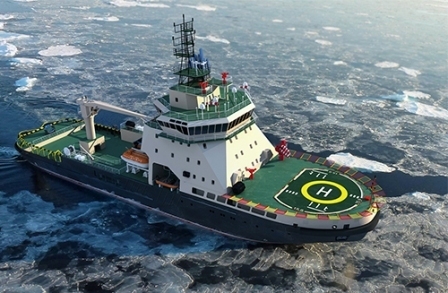A shipyard in St. Petersburg will begin production on the first in a series of military icebreakers in March, under the Russian Navy’s special project 21180. According to representatives of the Russian Ministry of Defence, the technical and detailed designs of the new vessels have been undertaken by Admiralty Shipyards.
It is expected that the new types of icebreakers will be on duty in the Arctic and the Far East, which is crucial for the Russian fleet, which in the coming year plans to launch large-scale exploration of its Arctic territory.
According to the developers, the icebreaker will have a modern energy rigging out, steerable propeller, and variable frequency speed drive. Displacement will be 6,000 tonnes, and the vessels will measure in at 84 metres in length, 20 metres in beam and 10 metres in depth. The vessels will have a range of 60 days and 10,500 nautical miles.
It is still unclear what weaponry the new ship will have. The designs of all Russian icebreakers constructed in the times of the Soviet Union were very flexible, allowing for the rapid installation and re-installation of various different fit outs, in case of large-scale war. However, the new types of icebreakers will be permanently equipped with some weaponry.
According to Russian analysts, icebreakers will probably be equipped with a number of self-defence armaments, in particular small-calibre anti-aircraft artillery and heavy machine guns, which do not take up much space. They may be also installed with missile launchers.
From another article, one can find an artist’s conception of the vessel:

I wonder where they are going to buy the propulsion system now that the sanctions are in place. There are only three manufacturers in the world capable of providing icebreaker-class azimuth thrusters, and all of those are located in Finland and thus likely subject to export restrictions when the vessel is intended for the Russian Navy. The same applies to diesel engines - Wärtsilä, MaK, Caterpillar etc. are all Western manufacturers.
In any case, those icebreakers seem to be in the same size and performance class as the icebreaking rescue vessels currently under construction in Germany. In terms of icebreaking capability, those are not that far from the new Canadian Arctic offshore patrol vessels.
http://en.portnews.ru/news/193598/
In any case, I wouldn’t put much hope on Russia’s ability to build modern icebreakers of ingenious design at domestic yards:
http://www.adn.com/article/20141126/russian-yard-delays-delivery-icebreaker


